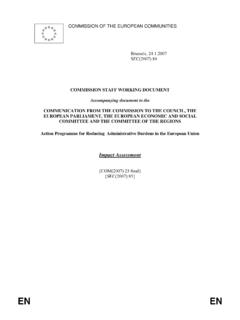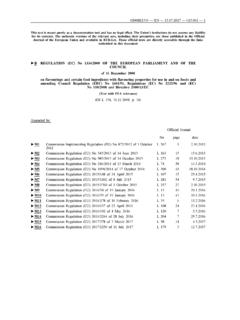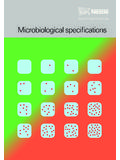Transcription of B COMMISSION REGULATION (EC) No 2073/2005 of 15 …
1 This text is meant purely as a documentation tool and has no legal effect. The Union's institutions do not assume any liability for its contents. The authentic versions of the relevant acts, including their preambles, are those published in the Official Journal of the European Union and available in EUR-Lex. Those official texts are directly accessible through the links embedded in this document B COMMISSION REGULATION (EC) no 2073 / 2005 of 15 November 2005 on microbiological criteria for foodstuffs (Text with EEA relevance) (OJ L 338, , p.)
2 1) Amended by: Official Journal No page date M1 COMMISSION REGULATION (EC) No 1441/2007 of 5 December 2007 L 322 12 M2 COMMISSION REGULATION (EU) No 365/2010 of 28 April 2010 L 107 9 M3 COMMISSION REGULATION (EU) No 1086/2011 of 27 October 2011 L 281 7 M4 COMMISSION REGULATION (EU) No 209/2013 of 11 March 2013 L 68 19 M5 COMMISSION REGULATION (EU) No 1019/2013 of 23 October 2013 L 282 46 M6 COMMISSION REGULATION (EU) No 217/2014 of 7 March 2014 L 69 93 M7 COMMISSION REGULATION (EU) 2015/2285 of 8 December 2015 L 323 2 M8 COMMISSION REGULATION (EU)
3 2017/1495 of 23 August 2017 L 218 1 Corrected by: C1 Corrigendum, OJ L 278, , p. 32 (2073/ 2005 ) C2 Corrigendum, OJ L 283, , p. 62 (2073/ 2005 ) C3 Corrigendum, OJ L 68, , p. 90 (1086/2011) C4 Corrigendum, OJ L 195, , p. 82 (1441/2007) C5 Corrigendum, OJ L 195, , p. 83 (1019/2013) 02005R2073 EN 102005R2073 EN 2 COMMISSION REGULATION (EC) no 2073 / 2005 of 15 November 2005 on microbiological criteria for foodstuffs (Text with EEA relevance) Article 1 Subject-matter and scope This REGULATION lays down the microbiological criteria for certain micro- organisms and the implementing rules to be complied with by food business operators when implementing the general and specific hygiene measures referred to in Article 4 of REGULATION (EC) No 852/2004.
4 The competent authority shall verify compliance with the rules and criteria laid down in this REGULATION in accordance with REGULATION (EC) No 882/2004, without prejudice to its right to undertake further sampling and analyses for the purpose of detecting and measuring other micro-organisms, their toxins or metabolites, either as a verification of processes, for food suspected of being unsafe, or in the context of a risk analysis. This REGULATION shall apply without prejudice to other specific rules for the control of micro-organisms laid down in Community legislation and in particular the health standards for foodstuffs laid down in REGULATION (EC) No 853/2004 of the European Parliament and of the Council ( 1 ), the rules on parasites laid down under REGULATION (EC) No 854/2004 of the European Parliament and of the Council ( 2 ) and the microbiological criteria laid down under Council Directive 80/777/EEC ( 3 ).
5 Article 2 Definitions The following definitions shall apply: (a) micro-organisms means bacteria, viruses, yeasts, moulds, algae, parasitic protozoa, microscopic parasitic helminths, and their toxins and metabolites; (b) microbiological criterion means a criterion defining the accepta bility of a product, a batch of foodstuffs or a process, based on the absence, presence or number of micro-organisms, and/or on the quantity of their toxins/metabolites, per unit(s) of mass, volume, area or batch; (c) food safety criterion means a criterion defining the acceptability of a product or a batch of foodstuff applicable to products placed on the market; (d) process hygiene criterion a criterion indicating the acceptable functioning of the production process.
6 Such a criterion is not applicable to products placed on the market. It sets an indicative contamination value above which corrective actions are required in order to maintain the hygiene of the process in compliance with food law; B ( 1 ) OJ L 139, , p. 55, corrected by OJ L 226, , p. 22. ( 2 ) OJ L 139, , p. 206, corrected by OJ L 226, , p. 83. ( 3 ) OJ L 229, , p. 1. 02005R2073 EN 3 (e) batch means a group or set of identifiable products obtained from a given process under practically identical circumstances and produced in a given place within one defined production period; (f) shelf-life means either the period corresponding to the period preceding the use by or the minimum durability date, as defined respectively in Articles 9 and 10 of Directive 2000/13/EC.
7 (g) ready-to-eat food means food intended by the producer or the manufacturer for direct human consumption without the need for cooking or other processing effective to eliminate or reduce to an acceptable level micro-organisms of concern; (h) food intended for infants means food specifically intended for infants, as defined in COMMISSION Directive 91/321/EEC ( 1 ); (i) food intended for special medical purposes means dietary food for special medical purposes, as defined in COMMISSION Directive 1999/21/EC ( 2 ); (j) sample means a set composed of one or several units or a portion of matter selected by different means in a population or in an important quantity of matter, which is intended to provide information on a given characteristic of the studied population or matter and to provide a basis for a decision concerning the popu lation or matter in question or concerning the process which has produced it; (k) representative sample means a sample in which the characteristics of the batch from which it is drawn are maintained.
8 This is in particular the case of a simple random sample where each of the items or increments of the batch has been given the same prob ability of entering the sample; (l) compliance with microbiological criteria means obtaining satis factory or acceptable results set in Annex I when testing against the values set for the criteria through the taking of samples, the conduct of analyses and the implementation of corrective action, in accordance with food law and the instructions given by the competent authority; M4 (m) the definition of sprouts in Article 2(a) of COMMISSION Implemen ting REGULATION (EU) No 208/2013 of 11 March 2013 on tracea bility requirements for sprouts and seeds intended for the production of sprouts ( 3 ).
9 B Article 3 General requirements 1. Food business operators shall ensure that foodstuffs comply with the relevant microbiological criteria set out in Annex I. To this end the food business operators at each stage of food production, processing and B ( 1 ) OJ L 175, , p. 35. ( 2 ) OJ L 91, , p. 29. ( 3 ) See page 16 of this Official Journal. 02005R2073 EN 4 distribution, including retail, shall take measures, as part of their procedures based on HACCP principles together with the implemen tation of good hygiene practice, to ensure the following: (a) that the supply, handling and processing of raw materials and food stuffs under their control are carried out in such a way that the process hygiene criteria are met, (b) that the food safety criteria applicable throughout the shelf-life of the products can be met under reasonably foreseeable conditions of distribution, storage and use.
10 2. As necessary, the food business operators responsible for the manufacture of the product shall conduct studies in accordance with Annex II in order to investigate compliance with the criteria throughout the shelf-life. In particular, this applies to ready-to-eat foods that are able to support the growth of Listeria monocytogenes and that may pose a Listeria monocytogenes risk for public health. Food businesses may collaborate in conducting those studies. Guidelines for conducting those studies may be included in the guides to good practice referred to in Article 7 of REGULATION (EC) No 852/2004. Article 4 Testing against criteria 1.















